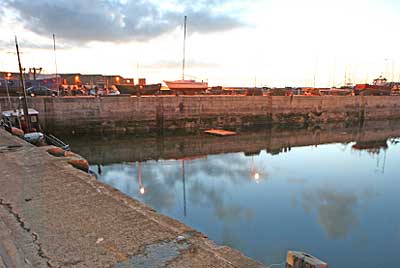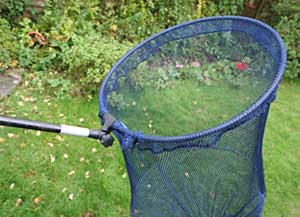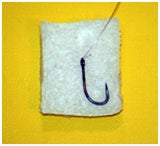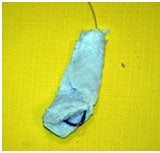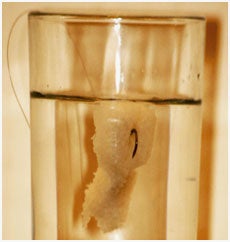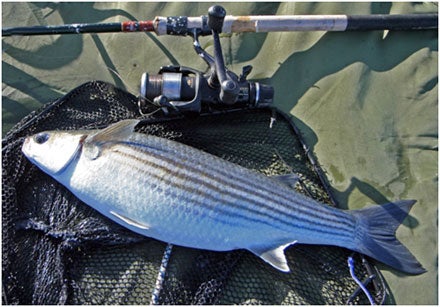Mullet ManMullet are a saltwater species, which on the face of it have a lot in common with freshwater fish. They can be caught on freshwater tackle; they respond well to freshwater baits and groundbaiting techniques and they can even be fished for from the comfort of your favourite fishing chair. They reach a good weight too (at least 15lbs) and for their size fight better than anything you are likely to encounter in salt or freshwater. There’s no need to hire a boat to get out into the deeps or tramp for agonising miles across shingle or soft sand; mullet can often be found in your local harbour conveniently close to the car. They are also a practical proposition for the angler travelling abroad since mullet are found almost everywhere.If you want to catch a few closer to home this year, there’s still time to do so but don’t leave it too late. Once the water temperature drops below about 10 degrees C the mullet move out. Mullet will feed throughout the year in warmer southern counties, particularly in the West Country but water temperature is still a deciding factor. We are talking Grey Mullet here and specifically the Thick Lipped variety. These are the mullet that are often found in harbours and around piers etc. Not to be confused with their close cousins, the Thin Lipped Mullet which are generally smaller and travel further up into freshwater, or the Golden Grey Mullet which prefers the open beaches and has a distinctive gold spot on its cheeks and is much less widespread. Izaak Walton famously wrote that the Chevin (chub) was the fearfullest of fishes. That’s only because there were never any mullet in his particular stretch of the River Lee! Compared to mullet though, chub are all prancing exhibitionists! Anyone who has put time in for mullet will know the frustration, anxiety, stress, anger and often dissolution and disappointment that goes hand in hand with a session whilst after these elusive and canny fish. Mullet then, as I’m sure you will know, are not easy to catch, but they are not outright impossible as some will tell you, and they can be caught fairly consistently if you get the preparation and technique right. To help ensure success with any difficult fish you need to do some homework and forward planning first. The most important part of this work involves finding a place where significant numbers of mullet can be found. This can be done by personal observation at typical mullet haunts. Look for a harbour, marina, jetty, pier etc, especially those in which fish are landed and fish guts etc are thrown in which will inevitably attract many species of fish, including mullet. Mullet often leave tell tale lip scrapes in the mud which are revealed at low tide and a clear give away that they are there and mooching about. The lip scrapes look like what you would get if you held the first two fingers of one hand together, pushed them into the mud about half a centimetre and drew them towards you for about 50mm, ie, two single indented lines drawn in the mud. Many people believe these marks are left by feeding swans, but mullet are the real culprits. Their lips have a peculiar ‘V’ profile and the marks are caused when they take in mouthfuls of mud to get at the tiny food particles that it contains. Mullet have evolved long intestines and an unusual digestive system, which allows them to exploit the meagre pickings from the mud. But they will take other larger and tastier offerings, and who can blame them! Mud though is not a feature of all mullet habitats and therefore Polaroid’s and floppy may seem the obvious order of the day. If you sit it out long enough at a likely looking spot you may see the odd mullet cruising up and down. You may see several or you may see none at all. The fact that you can’t see them though doesn’t mean that they are not there but seeing them gives you the confidence to fish with a degree of expectation. The truth is, mullet are pretty widely distributed and if you know of a location that fits the description, it’s a safe bet that it will hold a few mullet. The further south you live, the more likely that will be throughout the year. Without doubt though, the best way of locating a mullet hotspot is to get some local advice from a trustworthy source. This will obviously cut down on the preparation time, but believe me, very few people know anything at all about mullet fishing and those that do don’t hand out their precious knowledge to all and sundry. If you do see someone who is apparently fishing for mullet, wait for an opportune moment before approaching. Preferably when he is packing up. Make polite conversation but don’t of course intrude and don’t set up camp right beside him. Mullet men tend to be solitary by habit and won’t thank you for your company when they are fishing…, it ruins their concentration. Mullet demand one hundred percent concentration from you. More about that in a moment. Be polite and courteous and grateful to anyone who tips you the wink. I was in Co. Kerry, Ireland this year seeking mullet and my thanks are extended here to the very helpful chap from Bolton (of all places!) who not only gave me details of a superb local mullet venue, but also gave me his tide table. What generous and honourable sport angling can be! I hope he is reading this!
OK, so we have found a venue. What next?Well, let me describe a typical day. The venue my friend from Bolton put me onto was a big working harbour taking in commercial fishing boats, plus a few freighters and pleasure craft. It was at least twenty-five feet deep at the quayside at low water, so it never dries out and therefore fishing is possible at all states of the tide. (Deep water isn’t essential though, as mullet will inhabit very shallow water) It is busy and noisy with the sound of banging, sawing, cutting and grinding going on most of the time and of course, there are many boats entering and leaving the harbour throughout the day. This kind of activity doesn’t seem to bother mullet. I guess they get used to all sorts of disturbances and that of course works in our favour but don’t take liberties. Mullet will only feed confidently if they feel safe and secure. They may be seen cruising around all day long but if they see you up close or directly above them, they will likely spook and not feed.Bait Some mulleters add a can or two of sardines or pilchards to their mix. It all serves the same purpose, which is to draw the fish in. Put the groundbait into the bag and suspend it by a rope so that it is about half submerged in the water. The wave action helps to disperse it through the net but you will also need to give the rope a good shaking from time to time as the groundbait seems to get compacted after a while. Adjust the length of the rope as the tide rises or falls to keep the bag suspended in the water. What I’m after is a continuous rain of groundbait particles falling down through the water and scent and oil being dispersed by wind and tide. I’ll supplement this with free offerings of more groundbait that I’ll squeeze until it sinks and I’ll drop this under the bag so that it settles on the seabed below. I’ll also squeeze the crusts from the hook baits to make them sink and help draw fish in from further down tide as they disintegrate. I keep this up throughout the session using the little and often principle and I get through quite a bit of bait in the process. I’m going to use fresh thinly sliced white bread on the hook as I find this gives the most consistent results without the need to educate the fish to new bait. Mullet though have been caught on a variety of baits and many mullet men have their own personal favourites. Common alternatives are bacon rind and strips of belly pork, sweetcorn, and maggots. It’s probably worth experimenting with some of the modern pellets and pastes but I haven’t felt the need yet. Tackle Many mullet men would now rig up with a float and fish a lump of crust or flake just beneath the surface close to the bag. Not me. Not anymore. That system does catch mullet but I have had more consistent success by fishing bread flake legered hard on the bottom below the bag and that’s what I did on this particular day. I didn’t sit directly above the baited area. Instead I set up camp several metres away so that my line went down to the bait at a shallow angle. This helps prevent line bites and offers less resistance to a taking fish. The gear I use will be familiar to every coarse angler. A simple sliding leger on 6lb Diawa Sensor straight through to a size 6 Drennan Super Specialist hook tied on with a Palomar knot. You need a strong but light sharp hook and these are almost perfect for me. A slightly longer shank would be ideal. The distance between hook and sinker should be kept short. Between 6 – 9 inches is best. A short link helps to indicate fish interest before the bait can be sucked off. In clear shallow water it pays to paint the hook white with Tippex and some people swear by the new fluorocarbon lines too, but I’ll stick to Diawa Sensor for most of my mullet fishing. I use a small to medium size fixed spool reel with a reliable clutch. I’m not into back-winding as I always manage to get the line tangled at some stage. If I hook a mullet I must be prepared to let it take line or I will surely loose it and mullet fight long and hard. If you do manage to hook one from a harbour or jetty and there is no way down to the water line, you will need a drop net. Dropnets are not easy things to use, especially if you are fishing alone and even more so if the sea is rough or if there is any wind or tide to contend with. My advice is to get a big one and clip at least 1lb of lead to the bottom to prevent it blowing around too much. Use stout rope that you can get a good grip on rather than thin twine. I get the fish completely exhausted before trying to land it and since they are immensely strong fit fish, this can take some time on the light gear. Once it is tuckered out, get its mouth above water for a few seconds so that it is gulping air and it will then roll over onto its side. Then it can be hand lined into the drop net. Get the net a foot or so below the surface and draw the fish over it.* Before hoisting the net up, allow the fish to rest and recuperate in the water for a few moments to get its breath back. This ensures a quick and complete recovery and the fish will swim away strongly when returned. Watch a sprinter after crossing the winning line. All that exertion during the race has starved muscles and vital organs of life giving oxygen. He sucks in great lungfuls of air as his body slowly returns to normal. Imagine how you would feel if someone ducked your head under water immediately after a 100 metre dash! I always give big fish time to recover in the net. It works especially well with barbel, a species that is often slow to recover after unhooking.
*Using a drop net sounds a lot easier than it actually is and a better method is called for. I have adapted an adjustable keepnet which makes the operation more straightforward. I can use my net as a conventional landing net with a handle, or alter the connecting angle up to 90 degrees, which makes vertical landing from a dockside a doddle provided the fish is within reach. I have seriously considered utilising a set of drain rods that can be quickly connected together to reach the parts that my exciting handle cannot reach! I recommend a fairly soft through action rod and I like my 11ft Avon. I’ll use the quiver tip on very calm windless days and the Avon tip for all other times. You certainly don’t want the tip moving around at all. If I’m on the Avon tip, I’ll be touch legering with the line over my middle finger and striking at the slightest indication, so I’ll have the length of the rod pointing towards the bait and watching the line more than the tip. The weight of the sinker is important. You need to get the bait down quickly, and get the reel line tight to the tip without delay. Cast slightly beyond the baited area and let the sinker fall through an arc into the hot spot, maintaining contact by feel all the way to the bottom. The weight needs to be heavy enough to hold the line fairly taut, but not so heavy that it unbalances the rig. I find something between 1 – 2 ounces is usually about right but you may have to increase this if there is any tidal movement. The reason you need to get the bait down and the line tight quickly is because when they are in your swim and competing for the food, mullet takes can come surprisingly quickly. You often get a bite as soon as the flake settles on the bottom. If your line is slack, you won’t even see it. The fish will suck the fluffy flake off and be gone. They never return to the bait once the fluffy bit has been sucked off, so you really need to concentrate and anticipate the bites. (That’s why we don’t appreciate visitors!). Hold the rod all the time. Mullet bites tend to be mere suggestions and as you only get one bite per piece of flake, you have to be ready for it. Typically, you will feel just a very gentle single tug, or a slight tightening of the line; often not even enough to move the tip a centimetre. You must strike at anything suspicious. You may think that a tiny fish is mouthing the bait. Don’t be fooled. Mullet don’t do wrap rounds. Strike! Nine times out of ten, you will probably not connect; that’s mullet fishing. But eventually you will, so treat every nudge and knock as a potential mullet. Now here’s a funny thing: don’t be surprised if a huge shoal of mackerel move into your swim even in an enclosed harbour. I have had days when they have been so thick in front of me that there’s hardly any chance of a mullet getting to the bait first. Once a shoal of mackerel homes in on the groundbait they can polish it of in no time at all and it’s impossible to feed them off simply because there are just too many of them. Once they have picked up the scent, they often get hungry and switch on to feed mode. They seem to become pre-occupied with the groundbait and bread. I have known several occasions where I have caught dozens of mackerel on bread flake and the lads along the jetty haven’t caught a single fish on the traditional feathers or legered baits. At first I thought the mackerel were being fooled by the bread and mistaking it for small white fish, but this definitely is not the case as I have gutted mackerel that have been stuffed to the gills with my groundbait. Why this is so, I can’t say. It’s not like bread and groundbait are their normal food, but then again, it’s not usually the food of mullet either! Using bread flake – Bait presentation is the number one factor for success with mullet. Groundbaiting runs a close second. Mullet in my experience will not touch the firmer flake that secures the bait to the hook shank. It is therefore crucial that the bait you offer them incorporates a small fluffy bit of flake into which the hook is hidden but with the hook point standing clear, allowing it a good chance of taking hold. I like to cut up my flake with a pair of scissors. I start by cutting out a 25mm x 25mm square from a slice of very fresh thinly sliced bread. Moist fresh bread stays on the hook much better than dry crumbly day old stuff. I then lay the hook on the flake and fold and squeeze the flake onto the shank. I’ll fold the flake a second time and mould it like a sausage to ensure a good grip on the shank but leave the soft fluffy flake near the bend of the hook. You don’t want too much, only enough for the mullet to take it and the hook into its mouth. If it’s too big, the mullet simply suck the flake off without taking the hook. Trim the bait up with the scissors. Be very fussy about this. If you are not happy with the result, pull it off and start again. |
|
|
|
See how the flake swells once it absorbs water. Practice baiting a hook at home and dunk it in a glass of cold water. You will be amazed at just how big the fluffy flake will grow. Big lumps of flake are all well and good for chub and of course mullet will have no difficulty taking them either, but hooking is more assured if you use smaller baits because there’s more chance of the hook being inside the mouth when you strike. Notice how the flake ‘pops up’ naturally.
I was perched on the side of the quay concentrating hard but out of the side of my eye I spotted a huge bass, getting on for double figures, come up and engulf a piece of crust that I had thrown in earlier. (Yes bass in harbours will also take bread on occasion!) My mind was racing. Do I reel in and put out a float and try for the bass, or do I stick it out on the bottom for a mullet? Oh the agony of choice! Well, what would you do? I had just about made up my mind when I felt the line that was draped over my finger tighten ever so gently. My reaction was instinctive and the rod bent into a satisfying arc. The fish felt like a good one, staying deep and heading out into the channel against the singing clutch. I had two objectives: one to land the fish and the other not to draw attention to myself. The last thing I need is for other anglers to appear who will take up my precious time or worst still, skyline and spook the rest of the shoal. I want to get this fish landed and get the gear back into the water and try for another before the shoal moves on. I had by now, forgotten all about that bass. I kept the rod hidden over the side of the quay to avoid detection and played the fish with the rod upside down as it were, occasionally using side strain when all else failed. A car drove slowly past heading for the car park and the driver and his elderly wife smiled and nodded at me and I casually smiled back and lipped a friendly hello. Neither occupant had the faintest idea that at the other end of my line was a charging angry torpedo heading out to sea. Eventually, the fish and my right arm grew tired but I knew I had won. She lay on the un-hooking mat, her scales glistening in the soft afternoon sunshine. Absolutely fin-perfect she was. Firm and taught though I must say, I’ve never seen a ragged looking mullet. They are all fighting fit and almost certainly never been caught before. That’s another thing that makes them special. Completely wild fish in the truest sense. We don’t give them names and personalities. They are just mullet. We know it and so do they. No need for any human affectation here.
I got the gear back into the water and immediately hooked another. This one charged about much the same as the last but as it came nearer the surface, I could clearly see that a dozen or so other mullet were following it round and round much as perch will do when one of the shoal is hooked. That put paid to the bites for a bit so I stoked up the loose groundbait and gave the bag a good old shakeup, A short while later a gleaming 4 x 4 drew up alongside, its diesel engine rattling noisily. It towered above me as the window came down. I pulled my hook through the flake with a quick flick of the wrist and stood up to hear him speak. Inside, surrounded by black leather and mock walnut, sat two overweight middle aged men. English as it turned out. Each dressed from head to toe in tweed of the type that only the best dressed salmon anglers might be seen dead wearing. Right down to the funny little hats. I guessed they were brothers and although I couldn’t be sure, I suspected they were even wearing plus fours and brown brogues! “Are there any sea bass about?” he drawled, careful not to make eye contact. His words not a friendly conversational tone, but more of someone enquiring as to what’s on the menu. He immediately irritated me.I’ve never heard anyone apart from a cook on the telly refer to bass as “Sea Bass”. Off they went and I got back to the fishing. I could see the water in my swim was literally fizzing with activity and commotion. Before I had even time to think what could be causing it, a guillemot popped up. A first for me. I’ve come across everything in my swims from dogs to frogmen, but I’ve never been this close to a guillemot! He swam around a bit like a penguin before diving back down with an audible ‘plop’. After a few minutes he buzzed off and left me alone again. Then another slight tug. I struck and felt the heavy presence of something, which was definitely not a mullet. I reeled in a huge edible crab, fairly caught with my size 6 stuck firmly between those horny plates in the front of its mouth. It was about 8 inches across the carapace but strangely, and quite tragically, it had lost both of its large claws. I was left wondering how it managed to feed and get my hook in its mouth but clearly it did, so I wished him well and dropped him back over the side. I heard later that some commercial crabbers are breaking off and keeping just the claws from edible crabs. They throw back the bodies in the belief that the claws will re-grow and can then be re-harvested at a later date. I hope this isn’t true! I caught another four mullet that day and countless mackerel. All the mullet were caught on the bottom and I never saw a single fish other than mackerel anywhere near my groundbait bag, The mackerel dashed around in short rapid bursts as I threw them bread. They looked and behaved exactly as the mackerel do on the BBC2 opening sequence. Had I been fishing for the mullet conventionally on the float just below the surface, I’m sure I would have finished with a dry net. At one stage, when it was quiet and the light was fading and most of the other anglers and visitors had gone home, I got the fly rod out of the car and caught a few more mackerel just for the fun of it. I must have looked an odd sight on the side of that harbour flicking a fly around but in Ireland I guess anything goes. Kevin Thornton |










